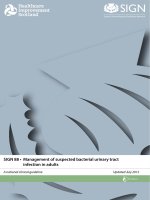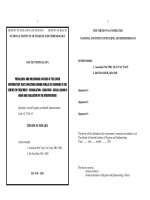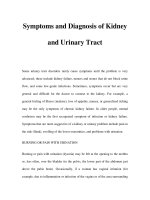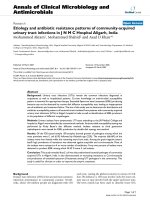Changing trends in antibiotic resistance of organism from urinary tract infections over five years in VIMS Ballari, Karnataka, India
Bạn đang xem bản rút gọn của tài liệu. Xem và tải ngay bản đầy đủ của tài liệu tại đây (185.02 KB, 4 trang )
Int.J.Curr.Microbiol.App.Sci (2017) 6(6): 2522-2525
International Journal of Current Microbiology and Applied Sciences
ISSN: 2319-7706 Volume 6 Number 6 (2017) pp. 2522-2525
Journal homepage:
Original Research Article
/>
Changing Trends in Antibiotic Resistance of Organism from Urinary Tract
Infections Over Five Years in VIMS Ballari, Karnataka, India
Mariraj Jeer and Khutija Sarah*
Department of Microbiology, VIMS Ballari, India
*Corresponding author
ABSTRACT
Keywords
Urinary tract
infection,
Antibiotic
Resistance,
Ciprofloxacin.
Article Info
Accepted:
29 May 2017
Available Online:
10 June 2017
The aim of the present study was to examine the changes in the trend of antibiotic
resistance of organisms from urinary tract infection over a five-year period in our hospital.
The data selected were all urine cultures from the hospital urine samples over a five-year
period. Results of urine cultures from patients throughout the hospital were analysed and
information on susceptibility to four antibiotics i.e., Gentamycin, Amikacin, Ciprofloxacin
and Nitrofurantoin was collected. Total number of urine samples in the study period were
15949, out of which 5690(35.67%) showed the growth of bacteria with significant count.
E. coli was the commonest organism isolated followed by Klebsiella spp., Pseudomonas,
S. aureus and others. Ciprofloxacin resistance has been increasing since past five years
(2012 -33% and 2016-40%),and even gentamycin resistance has increased since past five
years in (2012-31% and 2016-33%) also statistically amikacin show rise in resistance
pattern(2012-31% compared to 2016-36%)As resistance to nitrofurantoin is less compared
to other drugs i.e., (2012-14% and in 2016-17%). Nitrofurantoin resistance is low
compared to other drugs. It is both cost effective and efficacious for empirical treatment of
uncomplicated UTIs therefore should be considered the mainstay of treatment of
uncomplicated UTIs. This can be switched to targeted therapy on the basis of definitive
subsequent culture and AST results.
Introduction
Urinary tract infection [UTI] is one of the
most common infections diagnosed in
outpatient and in hospitalized patients
(Vasudevan, 2014) worldwide about 150
million people are being diagnosed with
urinary
tract
infection
every
year
(Manikandan et al., 2011).
It is caused by gram positive and gram
negative organisms (Alsamarai et al., 2016).
Inappropriate use of antibiotics has led to
increasing resistance rates in Gram
negative
bacteria
against standard
antibiotics with the increase rate of extended
spectrum beta-lactamase in urinary organism,
the treatment of UTIs has become more
complex and more difficult (Alicem et al.,
2012). The purpose of this study is to
optimise outcomes which minimises excess
broad-spectrum antimicrobial use, which can
drive resistance selection pressures and be
associated with secondary problems such as
Clostridium difficile infection. It is important
to continually monitor changes in antibiotic
2522
Int.J.Curr.Microbiol.App.Sci (2017) 6(6): 2522-2525
susceptibility in order to ensure that treatment
remain appropriate (Penelope et al.,).
Materials and Methods
The data selected were all urine cultures from
the hospital urine samples over a five-year
period i.e., 2012 to 2016.
Results of urine cultures from patients
throughout the hospital were analysed and
Information on susceptibility to four
antibiotics i.e., Gentamycin, Amikacin,
Ciprofloxacin, Nitrofurantoin were collected.
Results and Discussion
Total number of urine samples in the study
period were 15949, out of which 5690
(35.67%) showed the growth of bacteria with
significant count. E. coli was the commonest
organism isolated followed by Klebsiella spp.
Pseudomonas, S. aureus and others (Figs. 1
and 2). Ciprofloxacin resistance has been
increasing since past five years (2012 -33%
and 2016-40%) and even gentamycin
resistance has increased since past five years
in (2012-31% and 2016-33%) also
statistically amikacin show rise in resistance
pattern (2012-31% compared to 2016-36%),
As resistance to Nitrofurantoin is less
compared to other drugs i.e., (2012-14% and
in 2016-17%).
UTIs are the most common bacterial
infections among the community and
hospital-acquired infections. In recent years,
resistance rates to commonly used antibiotics
increase rapidly and the treatment of UTIs has
become more difficult (Alicem et al.,),
ciprofloxacin resistance has been increasing
since past five years (2012: 33% and 2016:
40%), and even gentamycin resistance has
increased since past five years in (2012: 31%
and 2016: 33%) also statistically amikacin
show rise in resistance pattern (2012: 31%
compared to 2016: 36%). and resistance to
Nitrofurantoin is less compared to other drugs
(i.e., 2012-14% and in 2016-17%) (Fig. 3).
Nitrofurantoin
is
a
broad-spectrum
bactericidal antibiotic, and it is use for more
than four decades no clinically significant
resistance has developed, as seen with other
commonly used antibiotics. This is probably
because Nitrofurantoin has multiple sites and
levels of action in contrast to antibiotics that
attack a single target like ampicillin or two
targets like cotrimoxazole.
Fig.1 Positive and negative culture of urine samples
2523
Int.J.Curr.Microbiol.App.Sci (2017) 6(6): 2522-2525
Fig.2 Common organism isolated in study
Fig.3 Sensitivity of the drugs in the following years
Bacterial nitroreductase enzyme converts
nitrofurantoin to highly reactive electrophilic
intermediates which non-specifically attack
bacterial ribosomal proteins resulting in
complete inhibition of protein synthesis
(McOsker et al., 1994), and cause singlestrand breaks in DNA (McCalla et al., 1970).
Nitrofurantoin is usually well tolerated.
Side‑effects occur at rates <0.001%
Nitrofurantoin is active against most common
uropathogens including E. coli, Citrobacter
spp, Staphylococcus saprophyticus and
Enterococcus spp. Whereas, Enterobacter
spp. and Klebsiella spp. are only moderately
inhibited, Proteus spp, Providencia spp,
Morganella
morgannii,
Serratia
sp,
Pseudomonas spp., and Acinetobacter spp.
are mostly resistant to nitrofurantoin (Ronald
et al., 1967; Barry, 1990).
In conclusion nitrofurantoin resistance is low
compared to other drugs. It is both cost
effective and efficacious for empirical
treatment of uncomplicated UTIs therefore
should be considered the mainstay of
treatment of uncomplicated UTIs, since most
of the organism like E. coli, Staphylococcus
are regularly isolated from urine samples.
Nitrofurantoin can be an alternative antibiotic
but to be used judiciously.
References
Alicem Tekin, et al. 2012. In vitro efficasy of
nitrofurantoin and some antibiotics in E.
coli strain isolated from urine culture,
New J. Med., 29(2): 89-91.
Alicem Tekin, Tuba Dal, Özcan Deveci,
Recep Tekin, Hasan Bozdağ, Tuncer
2524
Int.J.Curr.Microbiol.App.Sci (2017) 6(6): 2522-2525
Özekinci. In Vitro Efficacy of
Nitrofurantoin and Some Antibiotics in
Escherichia coli Strains Isolated from
Urine Cultures. Dicle University
Faculty of Medicine Department of
Medical
Microbiology,
DİYARBAKIRDicle University Faculty
of Medicine Department of Infectious
Diseases, Diyarbakir.
Alsamarai, A.G.M., Ali, S. 2016. Urinary
tract infection in female in Kirkuk city,
Iraq:
causative
Nagents
and
antibiogram.
World
J.
Pharm.
Pharmaceut. Sci., 5(6): 261-273
Alsamarai, A.G.M., Ali, S. 2016. Urinary
tract infection in female in Kirkuk city,
Iraq: risk factors. World J. Pharm.
Pharmaceut. Sci., 5(6): 180-195.
Barry,
A.L.
1990.
Nitrofurantoin
susceptibility
test
criteria.
J.
Antimicrobial Chemother., 25: 711‑3.
Manikandan, S., et al. 2011. Antimicrobial
susceptibility pattern of urinary tract
infection causing human pathogenic
bacteria. Asian J. Med. Sci., 3(2): 56-60.
McCalla, D.R., et al. 1970. Mode of action of
nitrofurazone. J. Bacteriol., 104: 112634.
McOsker, C.C., et al. 1994. Nitrofurantoin:
mechanism of action and implications
for resistance development in common
uropathogens.
J.
Antimicrobial
Chemother., 33(Suppl A): 23-30.
Penelope Teoh, Adriana Basarab, Ruth
Pickering, Ahmed Ali, Matthew Hayes
and Bhaskar K. Somani. Changing
trends in antibiotic resistance for
urinary E. coli infections over five years
in a university hospital.
Ronald, A.R., Turck, M. 1967. Comparison of
oxafuradene and nitrofurantoin in vitro
and clinical assessment of oxafuradene
in bacteriuria. Antimicrob. Agents
Chemother., (Bethesda) 7: 506‑9.
Vasudevan, R. 2014. Urinary tract infection:
an overview of the infection and the
associated risk factors. J. Microbiol.
Exp.,
1:
00008.
DOI:10.15406/jmen.2014.01.00008.
How to cite this article:
Mariraj Jeer and Khutija Sarah. 2017. Changing Trends in Antibiotic Resistance of Organism
from Urinary Tract Infections Over Five Years in Vims Ballari. Int.J.Curr.Microbiol.App.Sci.
6(6): 2522-2525. doi: />
2525









